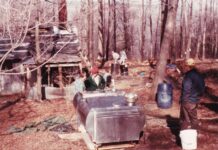“In 1850, New England was 70 percent open farmland and 30 percent woods. Today the proportions are exactly reversed. Probably no area in the developed world has undergone a more profound change in just a century or so, at least not in a contrary direction to the normal course of progress.”
– Bill Bryson
It hasn’t been all too many years ago that nearly everyone had some experience working on a farm.
Some, like me, were born in to it and had no choice of being put to work from a very young age.
The best way to make a farm grow was to put everyone in the family to work, pulling toward successful production and cash flow.
Summer jobs. But others, including many of my classmates, sought out farm jobs as a sure way of making a few dollars, especially during the summer.
Now, my kids’ friends tell me, it’s getting harder to find those jobs.
As a result, we are seeing kids with less ingenuity, less physical labor experience, less overall “working while thinking on your feet” experience.
Farming, the very landscape of it, continues to change, all across the United States.
But those changes are somewhat different in various regions of the country, from the stony landscape of New England to the incredibly dry conditions of the West.
“If you were going to be a farmer, you could hardly choose a worse place than New England,” Bryson writes in A Walk In The Woods.
He explains, “The soil is rocky, the terrain steep, and the weather so bad that people take actual pride in it. A year in Vermont, according to an old saw, is ‘nine months of winter followed by three months of very poor sledding.'”
Bryson notes that until the middle of the 19th century, “farmers survived in New England because they had proximity to the coastal cities like Boston and Portland and because, I suppose, they didn’t know any better.”
Farm story. He says that two things then happened to jog the course of New England’s farm story: “the invention of the McCormick reaper (which was ideally suited to the big, rolling farms of the Midwest but no good at all for the cramped, stony fields of New England) and the development of the railroads, which allowed the Midwestern farmers to get their produce to the East in a timely fashion.
“The New England farmers couldn’t compete, and so they became Midwestern farmers, too.
“By 1860, nearly half of Vermont-born people – 200,000 out of 450,000 – were living elsewhere.”
New England has since seen even prosperous orchards, once-thriving little businesses in their own right, fade in to upscale housing developments with pricey real estate tags.
Some regions, famous for hand-picked produce such as blueberries, have hired workers from other countries to provide labor, creating strained relations within entire communities.
Is this progress? As the incredibly topsoil-rich tillable acreage in this part of the world, the part of the world to which those Vermont farmers likely relocated, fades to concrete and grassy lawns, I keep wondering if this is truly progress.
Is it going to haunt us in some way, some day? What do you think?
Get 4 Weeks of Farm and Dairy Home Delivered












